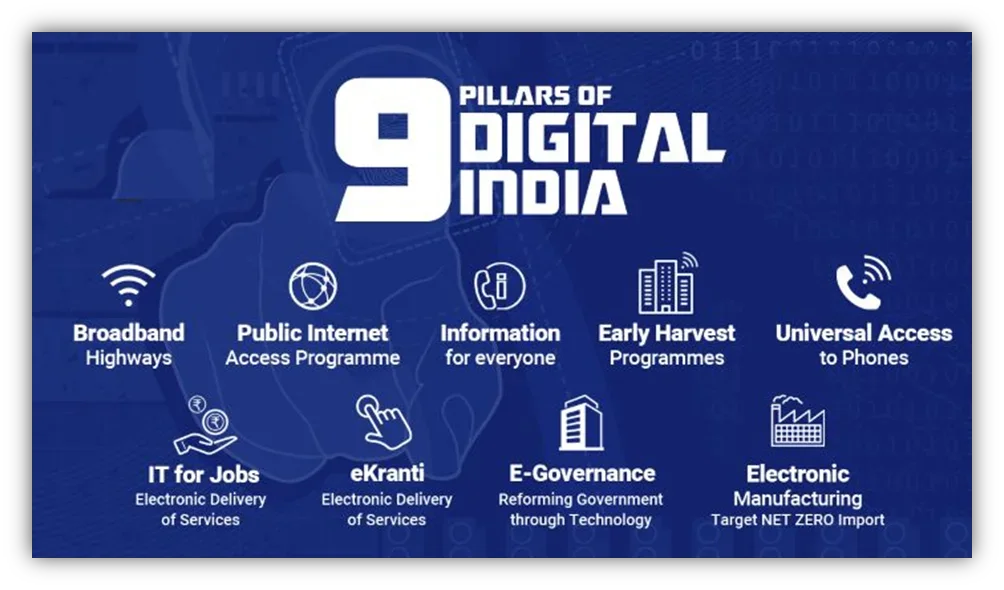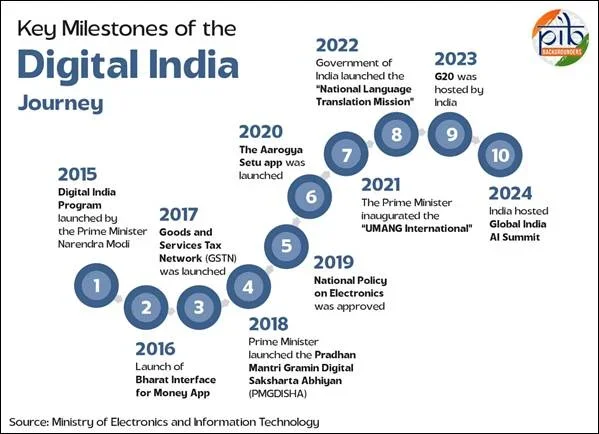Governance
10 Years of Digital India
- 01 Jul 2025
- 12 min read
For Prelims: Digital India, Financial Inclusion, Digital Infrastructure, Optical Fibre, UPI, Aadhaar, Open Network for Digital Commerce (ONDC), Government e-Marketplace (GeM), IndiaAI Mission (2024–29), India Semiconductor Mission, Karmayogi Bharat, iGOT, DigiLocker, UMANG App, BHASHINI, Common Service Centres, BharatNet, Digital Personal Data Protection (DPDP) Act, 2023, Cyber Surakshit Bharat, Skill India, PMGDISHA.
For Mains: Performance of Digital India, Key Issues Associated with Digital India and further measures needed to strengthen Digital India.
Why in News?
On 1st July 2025, India celebrated 10 years of Digital India, a flagship initiative launched in 2015 to bridge the digital divide and empower citizens through technology.
- Over the past decade (2015-25), Digital India has revolutionized internet access, governance, financial inclusion, and digital infrastructure, positioning India as the world’s third-largest digital economy.
What are Achievements of Digital India Since its Launch?
- Digital Infrastructure:
- Telecom & Internet Growth: Between 2014 and 2025, telephone connections rose from 93.3 crore to 120 crore (with tele-density increasing from 75.23% to 84.49%), while internet users grew by 285% and broadband connections surged by 1,452%.
- 5G Revolution: In just 22 months, 4.74 lakh 5G towers were installed, covering 99.6% of districts, while data costs fell sharply from Rs 308/GB (2014) to Rs 9.34/GB (2022).
- BharatNet for Rural India: 2.18 lakh Gram Panchayats have been connected through 6.92 lakh km of optical fibre, and 4G connectivity now reaches 6,15,836 villages across India.
- Digital Finance:
- Unified Payments Interface (UPI): As of April 2025, UPI facilitated 1,867.7 crore transactions worth Rs 24.77 lakh crore, accounting for 49% of global real-time transactions (2023); it is now operational in 7+ countries.
- Aadhaar & Direct Benefit Transfer (DBT): By April 2025, 142 crore Aadhaar IDs had been generated, enabling Rs 44 lakh crore to be transferred via DBT, which removed 5.87 crore fake ration cards and 4.23 crore duplicate LPG connections.
- ONDC & GeM: By 2025, the Open Network for Digital Commerce (ONDC) had onboarded lakhs of sellers, while the Government e-Marketplace (GeM) has over 22.5 lakh sellers and 1.6 lakh government buyers.
- AI and Semiconductors: The IndiaAI Mission (2024–29) has deployed over 34,000 GPUs by May 2025 to boost AI innovation, compute capacity, startups, and ethical AI frameworks, anchored by pillars like IndiaAI Innovation Centre, AIKosh, FutureSkills, and Safe & Trusted AI.
- The India Semiconductor Mission supports chip and display manufacturing with 50% capital assistance; 6 projects worth Rs 1.55 lakh crore have been approved (5 under construction).
- Citizen Empowerment: Karmayogi Bharat and iGOT have on boarded 1.21 crore officials, issuing 3.24 crore learning certificates, while platforms like DigiLocker (with 53.92 crore users) and the UMANG App (offering 2,300+ services in 23 languages with 8.34 crore users) have enhanced digital access and governance.
What is the Digital India Initiative?
- About: Digital India initiative was launched on 1st July 2015, to transform India into a digitally empowered society and knowledge-based economy by strengthening digital infrastructure, ensuring digital delivery of services, and promoting financial inclusion.
- Objective:
- Bridging the Digital Divide: Digital India aims to reduce the gap between digitally empowered citizens and those with limited access to technology.
- Ensuring Inclusive Digital Access: It promotes equal participation in the digital ecosystem, enabling access to education, healthcare, and government services for all.
- Driving Economic Growth: By leveraging technology and innovation, the initiative supports nationwide economic development.
- Improving Quality of Life: It seeks to raise living standards by integrating technology into key areas of daily life.
- Nine Pillars of Digital India Initiative:
- Broadband Highways: It aims to expand high-speed internet nationwide for better connectivity.
- Universal Mobile Access: It ensures mobile coverage in remote areas to boost digital inclusion.
- Public Internet Access: It sets up Common Service Centres in underserved regions to improve affordable access and digital literacy.
- E-Governance: It streamlines government services for better efficiency, transparency, and citizen engagement.
- E-Kranti: It delivers government services online via platforms like MyGov.in enhancing accessibility.
- Information for All: It promotes digitisation of records and open data for innovation.
- Electronics Manufacturing: It boosts local production, reducing imports and creating jobs.
- IT for Jobs: It builds youth IT skills through missions like Digital Literacy and Skill India.
- Early Harvest Programs: It addresses urgent digital needs like online certificates, digital attendance, and public Wi-Fi.
- Digital India Initiatives: Aadhaar (unique 12-digit biometric IDs), BharatNet (high-speed broadband to rural areas), Digital Locker (secure cloud storage of documents), BHIM UPI (secure digital payments), eSign (online document signing using digital signatures), MyGov (citizen participation in governance) etc.
- Key Milestones:
What are the Key Issues Associated with the Digital India Initiative?
- Digital Divide: India’s digital growth remains uneven, with rural internet penetration and digital literacy at only 37% (2023), highlighting stark gaps across regions and socio-economic groups.
- Cybersecurity Threats: Rising digital use has led to 13.91 lakh cyber security incidents (2022), but India faces a 8 lakh cyber security professional shortage, exposing weak cyber defenses.
- Data Privacy: Despite the Digital Personal Data Protection (DPDP) Act, 2023, concerns persist over enforcement and data misuse, with 61% of companies reportedly breaching consent norms.
- Infrastructure Bottlenecks: Low broadband speeds, patchy 5G, and poor fiber-optic coverage, especially in remote areas, limit digital access; India ranks 25th in mobile internet speed (2024).
- Regulatory Challenges: Frequent policy shifts, overlapping jurisdictions, and delays in spectrum auctions hinder 5G rollout and burden businesses with data localization costs.
- Public Digital System Issues: Platforms like CoWIN and Aadhaar face scalability, accuracy, and fraud challenges, especially in non-urban areas.
- Environmental Impact: Digital growth has increased e-waste from 1.01 MT (2019–20) to 1.751 MT (2023–24), worsened by weak e-waste management and high energy use in data centers.
What Measures can be Adopted to Further Strengthen the Digital India Initiative?
- Bridging the Digital Divide: Expand digital infrastructure in rural areas through BharatNet and PM-WANI, subsidize devices, and promote regional language content to boost access.
- Mandate assistive tech, support affordable internet, and integrate Accessible India with Digital India for marginalized groups.
- Enhancing Cybersecurity: Develop a comprehensive strategy, expand Cyber Surakshit Bharat, train professionals under Skill India, and support indigenous cybersecurity R&D via PLI schemes.
- Strengthening Data Privacy: Effectively enforce the DPDP Act, 2023, establish regional data protection offices, and clarify data localization guidelines.
- Promoting Digital Literacy: Extend PMGDISHA to cover cyber awareness and skills training, using community champions for outreach.
- E-Waste Management: Create a national framework linking Swachh Bharat to e-waste collection, support green startups, and extend PLI to eco-friendly tech.
- Integrating Digital Public Goods: Link platforms like Aadhaar, UPI, and DigiLocker to improve service delivery and reduce bureaucratic delays.
Conclusion
In its 10-year journey, Digital India has revolutionised service delivery, economic empowerment, and citizen participation. However, challenges like the digital divide, cybersecurity, and data privacy persist. With strategic reforms, inclusive infrastructure, and robust regulation, Digital India can become the cornerstone of Viksit Bharat, enabling equitable and sustainable digital growth.
|
Drishti Mains Question: Q. Digital India has bridged technological gaps but faces persistent challenges. Critically analyze this statement with reference to India’s digital transformation (2015–2025). |
UPSC Civil Services Examination Previous Year Question (PYQ)
Prelims
Q. Consider the following: (2022)
- Aarogya Setu
- CoWIN
- DigiLocker
- DIKSHA
Which of the above are built on top of open-source digital platforms?
(a) 1 and 2 only
(b) 2, 3 and 4 only
(c) 1, 3 and 4 only
(d) 1, 2, 3 and 4
Ans: (d)
Q. Which of the following is/are the aim/aims of “Digital India” Plan of the Government of India? (2018)
- Formation of India’s own Internet companies like China did.
- Establish a policy framework to encourage overseas multinational corporations that collect Big Data to build their large data centres within our national geographical boundaries.
- Connect many of our villages to the Internet and bring Wi-Fi to many of our schools, public places and major tourist centres.
Select the correct answer using the code given below:
(a) 1 and 2 only
(b) 3 only
(c) 2 and 3 only
(d) 1, 2 and 3
Ans: (b)
Q. Regarding ‘DigiLocker’, sometimes seen in the news, which of the following statements is/are correct? (2016)
- It is a digital locker system offered by the Government under Digital India Programme.
- It allows you to access your e-documents irrespective of your physical location.
Select the correct answer using the code given below:
(a) 1 only
(b) 2 only
(c) Both 1 and 2
(d) Neither 1 nor 2
Ans: (c)
Mains
Q. “The emergence of the Fourth Industrial Revolution (Digital Revolution) has initiated e-Governance as an integral part of government”. Discuss. (2020)
Q. How can the ‘Digital India’ programme help farmers to improve farm productivity and income? What steps has the Government taken in this regard? (2015).








